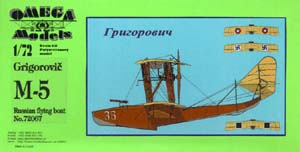Omega 1/72 Resin Grigorovich M.5 Flying Boat |  | Introduction Dimitry Pavlovich Grigorovich joined the Shchetinin aircraft factory in 1913 as an aircraft designer. At first they just turned out French designs such as the Nieuport and Farman, but after a damaged Donnet-Leveque flying boat was brought in for repair, Grigorovich turned to improving it and ultimately designing his own series of flying boats. The first of which, the M.1 (M for Morski - naval), was completed in Autumn 1913. The M.2-4 followed in small numbers and served as stepping stones to the next design which fully incorporated his ideas – the M.5. The M.5 was to be the first Grigorovich design to be produced in large numbers, with over 100 built. When used as a combat aircraft it was powered by a 100hp Clerget, when used in the trainer role it was given a 100hp Gnome-Monosoupape. Normally it carried a crew of two, with a Maxim machine gun on the right side for the observer. The type was soon phased out of frontline service due to its low top speed of 65 mph, but it survived until 1925 as a trainer. In addition to the IRAS and Soviet air forces it was also used by Finland and Turkey. The Kit Another interesting choice from Omega. The kit consists of 23 resin parts and a sheet of photo-etch. The resin parts are well cast and the only blemish I found was an air bubble in one of the propellor blades. The hull is cast with an opening for the cockpit and all internal detail is to be found on the PE sheet. The engine has separate cylinders. The wings only have raised ribs on the upper surfaces, and ever so slight indentations on the bottom – which is correct for the era. However the tail surfaces all have scribed ribs, and not raised ones, so new ribs will need to be added to these locations using stretched sprue or styrene. For those who have not tried making their own ribs, I suggest cutting thin strips of strip styrene and then stretching it as per HSP. .. it will retain its flat section and you can stretch it as thin as you like. The photo-etch is an integral part of this kit and includes the cockpit interior, as well as an innovative method of strut construction. The struts are designed to fold around a 1mm metal rod to gain their proper airfoil shape. The tail and engine mounting supports are also included on the fret. Instructions consist of exploded drawings showing the construction of the various steps. There are also side and top view drawings and two b/w profiles of a Finnish and Turkish boat. Markings are included for one IRAS, Finnish and Turkish option. Conclusion It remains to be seen as to the difficulty that the struts and mounting of the tail and engine will engender .. for that reason I would recommend this kit to those who have built a few WWI kits, or feel up to a challenge. My thanks to Lubos Vinar for the review sample. | 






|
